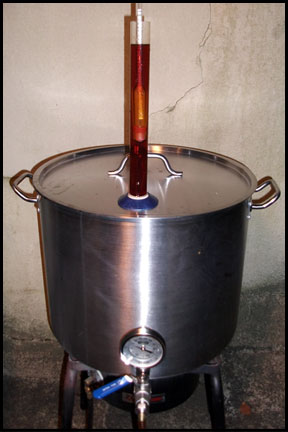Dubbel
Yesterday was the first brew day of 2010, and so far so good!
I brewed a 10 gallon batch of a Belgian-style Dubbel. Originally I was suppose to do this last week, but one key ingredient I was waiting on, Belgian Candi Syrup, had not arrived yet, so it was postponed until yesterday. It really is a shame that the local homebrew supply store does not carry this product for I feel as if there is no comparison, rock candy or the newer soft candy sugar. The reasoning was supposedly because it was too expensive, though I was willing to pay a premium price plus shipping to try and have it in time and still was not able to, disappointing.
Regardless, the brew day went relatively well after it got started. My typical starting time is 10AM which has me wrapping up by 5PM typically. Yesterday I just could not get going in the morning so the day didn’t start until 12PM and I didn’t wrap until 7PM. I have noticed that 10 gallon batches do take slightly longer than a 5 gallon batch, and the problem seems to be that I can’t heat my water fast enough, I suppose the quantity is just that much greater. For example, after I mashed in I began heating the water right away for the mash out water and sparge water, about 14 gallons total. It took 1 hour and 50 minutes to bring 10 gallons up to 170’F and the other 4 gallons up to 212’F, that’s 50 minutes longer than I would have preferred my mash rest to be. And lets not forget the heating of the foundation water, bringing the wort back to a boil, and my favorite cooling the wort to pitching temperature – which for once was a non-issue (thank you January freezing cold ground water!). One option is a more powerful burner for the burner stand, I believe mine is currently 75,000BTU and they really just go up from there, but so will propane consumption, which is already up with the larger batch sizes. Additionally, I think when the weather begins to warm it will be time for a wort chiller upgrade. I am currently leaning towards a counter-flow or plate chiller to help with time consumption, but the “new” immersion/whirlpool options seem pretty interesting too, we’ll have to see what time and money allows.
I was able to use the newly converted mash tun for the first time this batch, it went well. No leaks, and I only smacked the thermometer a few times. It was also more likely a better temperature ready too, the new thermometer is much closer to being in the middle of the tun which is most likely a better average of the overall temperature, versus before I used a digital thermometer on the surface (first 6 inches or so) of the tun, which always worked, but I always questioned it’s overall performance.
So currently there is 10 gallons of Dubbel popping away in my upstairs where it is warmer. I plan on leaving 5 gallons of this beer traditional and the other 5 gallons I plan on doing something. Currently I am leaning towards dry-spicing the beer of making a spice-neutral spirit (vodka) infusion and infusing the beer in secondary. I think I want to do a Chinese 5 Spice Dubbel. If I’m luck the spice and yeast profile and malt aspect of the beer will go together brilliantly, if I’m not so lucky I may have a lot of spicy cooking solution. Though I am a week off from my original brew date, I am aiming to have these beers wrap up quickly if all goes well. There are two homebrew competitions that are coming up in February that I’d like to enter these, and it’s been a while since I entered a competition. First is the War of the Worts XV which is February 20th but entries have to be received by the 7th, but if I judge (which I plan to) I may be able to bring them the day of the competition as long as they are already registered, which will buy my an extra 2 weeks. The second is a homebrew competition through McKenzie’s Brew House, which is a Belgian competition only, which need to be in by February 15th. This one is interesting for the winner gets have their recipe brewed on the McKenzie’s system and served at the pub, nice!
Oh, and just to keep you posted, the Fool Circle 10th Anniversary Stick-Icky DIPA was kegged yesterday, so theoretically it’ll be on tap by next weekend, very good news. It tasted delicious and smelt fantastic while kegging. Though I learned a lesson, removing 12oz of spent dry hops (read: wet hops) from a carboy sucks! I have not found an easy way yet to get all that hoppy goodness out of that little hole in an easy manner, oh well, it’s worth it! Though I was thinking, I wonder if there is a way to create a device or system that will keep the dry hops constantly moving in the fermenter? The reason I wonder is that I’ve always noticed that the dry hops float on top of the wort, after they are wetted they are immersed in the wort, but still at the top. It makes me wonder if the hops were constantly moving throughout the wort, thus creating an ever changing contact point between hop (lupilin) and wort would there be an increased efficiency. Maybe some way to bubble CO2 through the solution to create an environment that would force movement, or a very big and strong stir plate that would constantly swirl the solution … dunno, just thinking aloud.
